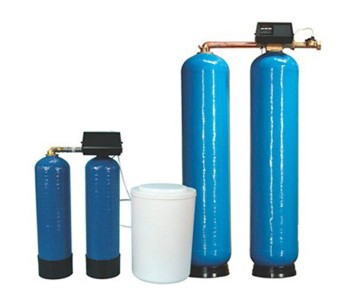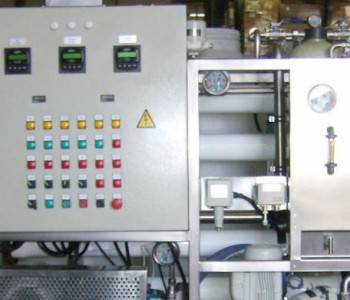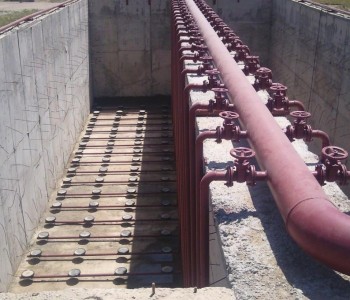GENERAL INFORMATION ABOUT REVERSE OSMOSIS Reverse Osmosis (RO) which is used in the purification process of well water and sea water is the most accurate filtration process possible. The RO system even separates ion state solids from water. In Reverse Osmosis systems a semi-permeable membrane is used as the main equipment. While the part of water filtrated to one side of the membrane is purified to a large extent, the remaining concentrated impurities at the other side are discharged. In Reverse Osmosis systems horizontal filtration principle is used in general, and the horizontal flow creates a constant cleaning effect on the membrane. While a part of the liquid is transferred to the product line of the membrane with the help of pressure, the remaining part is moved to the waste line through parallel flow to the membrane surface and removes the impurities separated from the liquid (e.g. salts, organic material) from the membrane. In the Reverse Osmosis (RO) process thrust power is needed for the liquid to be transferred to the other side of the membrane. The required thrust power is achieved by pump pressure. As the pressure rises, the power increases.
As the concentration of the liquid on the membrane increases, the thrust power needed for the liquid to pass to the other side of the membrane also increases. The most important advantage of the Reverse Osmosis system is its ability to filtrate at the ion level and its capacity to remove hardness and/or alkaline in the water as well other dissolved salts, to a large extent. With the Reverse Osmosis process, high quality water is obtained from brackish well water and/or sea water which are not drinkable or usable due to the high degree of salt concentration. As ions are filtrated in Reverse Osmosis (RO) systems, the suspended solids and consequently turbidity, have to be removed before the membrane process. The chemical and physical features of the untreated water have to be analyzed. With a Reverse Osmosis system that is designed accurately and that uses high quality equipment, it is possible to obtain sustained and high quality water more practically and at lower costs as compared to the other desalination systems.
Also known as hyperfiltration, reverse osmosis is the most sensitive filtration known. This process makes it possible to remove all particles in a solution including dissolved ions. Reverse osmosis is used to purify water for the purpose of improving its taste, odour and other properties and to remove the salt and other impurities in its constitution. It can also be used to separate ion and other pollutants from fluids such as glycol and ethanol which can pass from the membrane and to purify them. The most common usage of Reverse Osmosis is in the area of water purification. Reverse Osmosis is used to produce water that meets the most challenging specifications applied at the present. Reverse Osmosis functions with a semipermeable membrane that allows the fluid to be purified pass through but holds the remaining pollutants. Most of the Reverse Osmosis technologies take advantage of the cross flow principle that makes it possible for the membrane to constantly clean itself. While part of the fluid passes through the membrane, the remaining part continues forward and sweeps the material held on the membrane surface. The Reverse Osmosis (RO) process needs thrust power to transfer the fluid from the membrane and the most frequently used thrust power is the pump pressure energy. As the pressure rises, the thrust power increases. As the concentration of the separated fluid increases, the thrust power needed to concentrate the fluid also increases. Reverse Osmosis can remove bacteria, salt, sucrose, proteins, particles, pigments and other material at 150-250 dalton level and heavier, bigger molecules.
In Reverse Osmosis the ion removal efficiency increases with the effect of particle charge. This means that the removal of dissolved ions with ionic charge, such as salts, is realized more efficiently by the membrane than uncharged material such as organic material. The bigger the size of the particle and the higher the ionic charge, the more efficiently the Reverse Osmosis membrane removes it. Operating Principles The cross flow process is carried out by a machine consisting of membrane elements and their covers, connection piping, pumps, front filters, controls and instruments required for operation. The selection of the membrane should be made carefully as the cost of the membrane constitutes around 15-40% of the total cost of an RO or UF equipment and also because the membranes have to be periodically changed.
There are many types of membrane and each has special features of its own. Tolerance for chemicals, mechanic compatibility, washability, pollutant removal performance, flow performance and cost should be considered before selecting the membrane. As in other mechanic equipment, also in cross flow filtration devices, best performance is achieved when design and the material used are compatible. After the selection of the right membrane, a design that provides proper cross flow values, pressures and product water has to be made. A sound design will result in a device with consistent performance, less frequent membrane cleaning or changing, reasonable amount of energy consumption and minimum operation control. For most of these conditions to be met, the input water of the cross flow unit has to undergo pre-treatment. Investment in equipment for conditioning the water in a proper way before membrane treatment is very important as it is highly beneficial although its total cost is very low compared to the total cost of the system. At the input stage, cartridge or bag type filters have to be used to remove material up to 5 micron that cannot dissolve in water. Also, multi layered filters to eliminate turbidity and to filter oxidized metal such as iron and manganese are useful in most cases. Similarly, dosage pumps should be used as a means of dozing biocides to keep salts in dissolved state and to prevent biofouling due to acid and antiscalant or biological production. Depending on the nature of the input water, pre-treatment units such as settling tanks or active carbon filters may also be needed.
With proper pre-treatment, a membrane in a cross flow device will not bring more operation cost than predicted and the result will be optimum performance at the lowest unit cost. Cross flow filtration has a unique filtration and purification capacity especially for the removal of dissolved impurities with a size less than 0.1 micron. The cross flow process prevents the accumulation of the held impurities by sweeping the membrane surface continuously, thus making the membrane filtration processes cost effective. A successful organization depends on the selection of a proper membrane, device design and pre-treatment.

























































